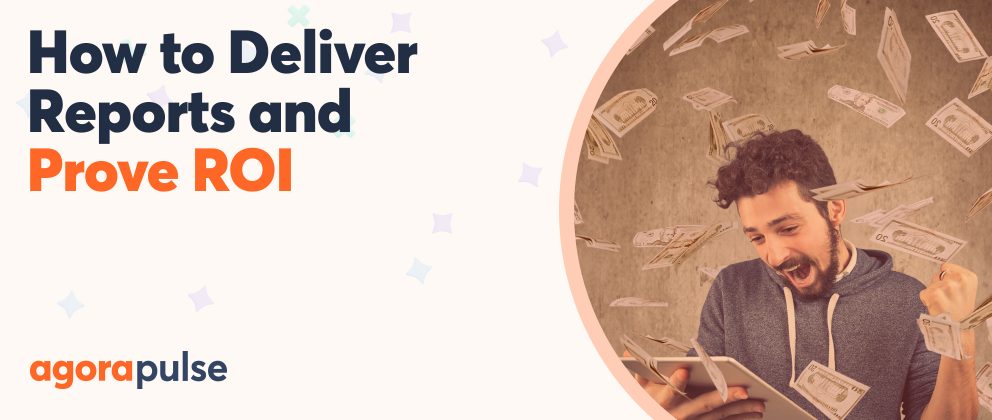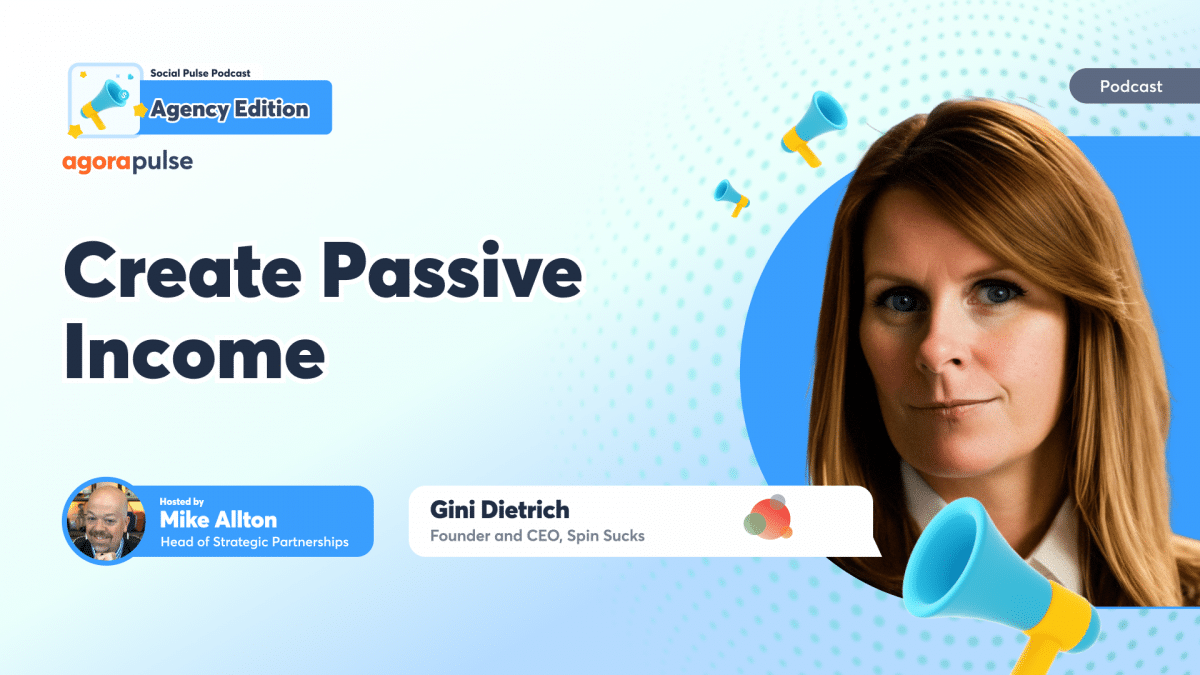Is your agency data-driven or more emotion- and hunch-driven? In today’s economy, you’ll want to be able to prove your social media campaigns work by looking at social media ROI.
But how?
During a recent Agency Summit, Christopher Penn gave an insightful talk about how agencies can deliver reports to their clients and tangibly demonstrate the value of their social media marketing activity.
Christopher Penn is an authority on analytics, digital marketing, and marketing technology. On top of being a top 100 digital marketer, successful entrepreneur, best-selling author of over two dozen marketing books, and a prolific keynote speaker, he’s also known for his thought-leadership and development of four key industry fields:
- Google analytics adoption
- Data-driven marketing and PR
- Modern email marketing
- AI and machine learning in marketing
Below are the key highlights of his session at Agency Summit.
The Biggest, Ongoing Problem for Agencies: Proving Social Media ROI
The one question that almost all agencies will get asked, at least once a month, is: What am I getting for my money?
And it’s a difficult question to answer, right?
Demonstrating the impact that your marketing activity is having on your client’s financial outcomes is a challenge.
For instance:
- 95% of agencies say they need access to data about their customers’ and clients’ preferences and needs.
- 92% say they need financial forecasts and projections.
- 92% say they need data about their brand and reputation.
But 15-20% of the time they’re unable to access this data, which is why less than half of agencies can prove Social Media ROI.
Instead, the best that agencies can do is create automated reports that show the number of clicks, likes, impressions, reach, and engagement they’ve landed.
Which, understandably, then prompts the question: What am I getting for my money? Because how does the number of likes an Instagram post affect how much revenue they make?
The problem is, we’re mixing activity up with results. And they are two very different things.
So how do we fix this?
We must become data-driven.
What Does It Mean to be Data-Driven?
Data-driven means you make decisions based on cold, hard data, not instinct or gut feelings.
You’re probably already more data-driven than you think. Each time you use Google Maps, for example, you put in a destination, it calculates the best route, and you follow it. The decisions you make are based on the data from Google Maps, not a gut feeling.
If you don’t use data to make decisions, you’re just guessing.
But how do you become a data-driven agency?
At the moment, you’re either making decisions using data, or you’re not. There’s no middle ground.
But here’s the shocker: Despite what you might think, becoming a data-driven agency isn’t about technology.
It’s about people.
It’s about persuading people to change the way they’ve always done things. It’s about getting people to learn how to harvest the right data sets, extrapolate the key information, and make solid decisions that are grounded in facts, not gut feelings.
There are four components that you and your agency staff must embrace if you want to become a data-driven agency that can prove Social Media ROI to clients and become a profit center, not a cost one.
The 4 Components of Data-Driven Decisions
Making decisions using data, not gut feelings, is like making a cake.
You can’t do it without the following four components:
- Ingredients
- A recipe
- Skills
- Tools
Data-driven decision making: The ingredients
Before making a cake, you must make sure that you’ve got all the ingredients you need, right?
It’s the same when you begin the journey to becoming data-driven. But instead of making sure that you have flour, eggs, sugar, and butter, the one ingredient you must have, ready to go, is high-quality data that reflects the KPIs that you and your client are being measured against.
Sourcing data is easy. But sourcing the right type of data isn’t.
We need to be collecting data that’s centered on KPIs.
First, ask your clients what their KPIs are: For example, are they measured on the number of leads they generate, or is it sales? Do they have targets around prospects, or is it SQLs?
Second, establish what data systems they use to measure progress towards KPIs and ask for access. You’ll probably find that most of them use Google Analytics to collect this data.
But not all clients like giving access to their accounts. This is where you need to make a strong case: Whatever type of agency you are, you need access to their Google Analytics and other data collection tools.
Once you have access, you then need to assess how good the data is. Data needs to be six things to be considered useful:
- Clean. It needs to be free of errors, with no duplicate entries.
- Complete. If there’s missing data, it’s a big problem that you need to fix.
- Comprehensive. Establish if the data is giving you the information you need. Is it tracking the right metrics? Granted, collecting data to prove Social Media ROI is challenging because such factors as agency fees, the lifetime value of customers, and internal costs will affect ROI. Take time to consider them.
- Chosen. Pick the metrics you want to track. In Google Analytics, there are over 510 metrics you can track, but you don’t need most of them. You don’t want irrelevant data to confuse the mix. Use the 80/20 rule and choose the metrics that matter.
- Credible. The data must be collected in a valid way. This can often be a problem for agencies that conduct surveys, polls, or marketing research because the data can be biased and, therefore, invalid.
- Calculable. Last, but not least, the data must be usable.
Trust Christopher Penn when he says: “If their data is poor in quality, you need to fix it. It’s worth the time.”
In summary: Make sure you have access to the right, high-quality ingredients that tie into the KPIs that your client is being measured on.
Data-driven decision making: The recipe
The next step, when making a cake, is to find and follow a recipe to make sure that the ingredients you’ve sourced make a yummy cake.
It’s the same when it comes to processing the data that you’ve collected. You need to follow a recipe to make sure that the data you present means something to the client. You have recipes for onboarding, you need them for data processing too.
Many agencies make the mistake of presenting data in a series of slides. These slides are filled with screenshots of ads, examples of work they’ve done, and graphs and tables that display metrics that the client is expected to interpret themselves.
But that isn’t their job, it’s yours.
This is why you need a recipe for processing and presenting data so that you’re delivering meaningful results, in a way that’s easy to understand.
Your recipe should ensure that every bit of data you process and present does two things:
- It tells them something they don’t know.
- It asks them for a decision.
Data without decisions is a distraction.
You can include all the charts, graphs, and tables you like, but if you’re not asking the client for a decision, you’re wasting their time … and yours. For example, if ad performance was down by 23% one month, you should inform them, suggest you pause or stop the campaign, and ask the client for a decision.
Your data processing recipe should always answer the Three Whats:
- What happened? First, you need to describe what happened. For example, we spent $X on this ad campaign, and we got X many clicks, impressions, and conversions.
- What does this mean? Next, you need to explain why this data matters. Why should the client care? For example, we got X number of clicks, impressions, and conversions which means that this ad campaign is performing X% better than we expected.
- What now? Then, you need to establish what decisions you need the client to make. For example, because the ad campaign performed better than we expected, we’d like to increase our budget spend by $X: Yes, or No?
A common recipe that many agencies use, that incorporates the three whats is the SAINT reporting framework:
- Summary
- Analysis
- Insights
- Next Steps
- Timeline
When you change your data processing and reporting format, it changes the entire conversation and relationship between you and the client. That type of approach allows you to become more proactive and you start to lead them, rather than them leading you.
So, develop your agency recipe book: Collect and write out different processes and frameworks for utilizing data so that you can tailor your approach to suit individual clients, and help them to understand what happened, why it happened, and what the next steps need to be.
Data-driven decision making: The skills
You can’t bake a decent cake without a degree of skill. The same goes for making data-driven decisions.
Establish what skills you need and evaluate everyone in your agency, from the top to the bottom, to see where they are with their data skills and maturity.
You need people that can harvest relevant, good-quality data, interpret it, and present it to clients. You need them to look at the data, understand the context, forecast what’s likely to happen in the future, and use this information to plan strategies.
For instance, people with analytical skills can predict when the best time to launch an email campaign would be, based on factors like public holidays, the weather, or economic changes.
This type of insight allows you to be proactive and demonstrate added value.
If you lack staff with data skills, hire someone. Normally, within agencies, you want to hire creative, blue-sky thinkers. But consider hiring someone with a background in analytics with qualitative, diagnostic skills, instead.
Data-driven decision making: The tools
Again, you can’t make a cake without tools. At the very least you need a bowl, spoon, and weighing scales. Similarly, you can’t become data-driven without tools.
But which ones do you use?
The best piece of advice Christopher Penn gave in his talk at the Agency Summit was: Don’t buy more tools to help you become data-driven. Use the ones you have.
Just like in cooking. Say you needed a rolling pin but didn’t own one, you’d improvise and use what you have wouldn’t you? (From experience, an empty wine bottle works well.)
You have access to a wide variety of free analytic and data tools, so squeeze whatever you can out of them, or hire people who can.
Most tools do the same thing, anyway. For example, tools like Ahrefs, SEMRush, and Moz Keyword Explorer all give you keyword data and keyword suggestions. So, save your pennies and use what you have.
Or if you want to pay for a tool, make sure you get a comprehensive tool that makes data collection, processing, and reporting super quick and easy.
Like Agorapulse, for example.
Agorapulse is a social media management tool with a difference: It’s the only platform that allows you to prove Social Media ROI. You can add UTM parameters to your content automatically, connect your account to Google Analytics, and pull in data that you can use to build comprehensive ROI reports for your clients. It makes proving ROI effortless.
Summary
Making proactive, data-driven decisions will allow you to demonstrate added value to your clients, enable them to see you as an expert, and stop the “What am I getting for my money?” question.
You’ll become an asset rather than a drain.
To become data-driven you must:
- Be crystal clear about the KPIs you’re trying to hit.
- Use high-quality data to lead rather than follow.
- Build your agency recipe book to help you process data that’s meaningful.
- Squeeze the juice from the tools you already use.
That’s how you go from being a cost center to a value center.
Sign up now for a FREE demo of Agorapulse and find out how you can start measuring your social media ROI today.






